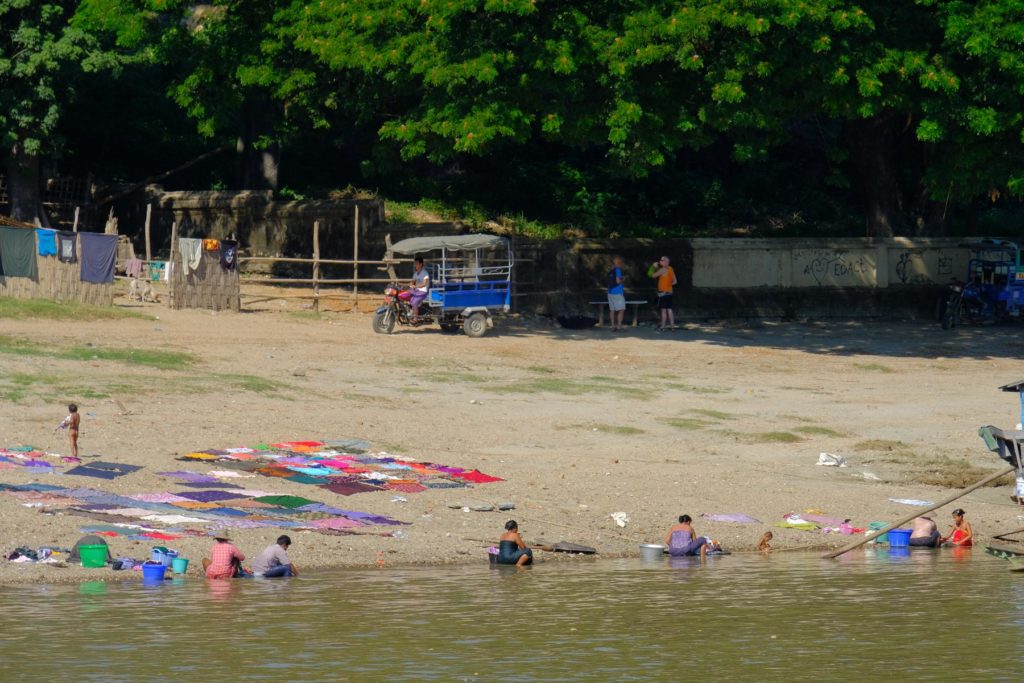This time there are two blog postings: my usual day summary and notes that Judy has been making about Myanmar and its culture. It will follow this posting’s pictures. Take a look!
Today we cruised up the Irrawaddy River to the town of Mingun. The trip was very pleasant. Despite the heat the breeze and shade provided by the boat made travel very comfortable. It’s a busy river with fishing, cargo and of course tourist boats.
Boarding the boat put the Adventure in to Overseas Adventure Travel. We had to traverse four gangways made up of 6-inch wide planks with plenty of bounce. The crew held bamboo poles up for us to use as guardrails. But we all made it!
Before boarding Daniel took us a few hundred yards beyond the boat ramp to see how some river people live. These folks live in tents and platforms along the beach, dwellings that are minimal even by Myanmar standards. In fact, one could argue they are homeless in that during the rainy season the river level climbs to engulf their dry-season locations. I’m not sure where they go in the rainy season but I suspect they return to the far side of the river and higher ground.
One main source of income is bringing sand from the numerous sandbars in the river and depositing it in piles on the riverbank for sale to Mandalay’s construction crews. The process is to first dig the sand and load it into long, low motor driven boats and take it to the Mandalay shore. The sand is shoveled from the boats into baskets. The baskets, 50 pounds worth, are carried on the heads of the workers 100 yards or so to the pile. These are family operations; small kids were numerous so someone has to stay behind to mind the youngsters but everyone else, men and women, pitch in and help.
Some groups deal in wood products, some of which is procured illegally and brought from the far side to Mandalay for use as firewood.
Daniel introduced us to a woman whose job is to bring earthenware containers from boats along the shore to the road. These are not light; one or two would be a good load. But this woman demonstrated carrying four at once, balancing one on top of the others. Daniel first met her when she was carrying five at once while she was very much pregnant.
The Mingun Pahtodawgyi is a huge pagoda started by King Bodawpaya in 1790. It stands almost 500 feet tall. Things did not work out very well, however. First, an astrologer warned the king that he would die when construction was complete. That brought construction to a halt. Then, in 1839 an earthquake did considerable damage. As recently as last year yet another earthquake did further damage.
The pagoda also has the world’s biggest playable bell (the biggest bell is in Red Square, Moscow but it was cracked when cast and has never been rung). I nearly got caught on my backpack trying to crawl out from under the bell. Talk about embarrassing!
Just a couple of hundred yards from the great stupa and bell lies the beautiful white Hsinbyume or Myatheindan Pagoda. It takes 99 stair steps to get to the top. Did I climb it? Of course I did, barefoot no less.
The return trip to Mandalay was quicker, traveling downstream and downwind as we were. Daniel took us to the Golden Duck restaurant for, what else in Mandalay, Peking Duck. Mandalay has a significant Chinese population although strictly speaking they are not Chinese people who immigrated to Myanmar. Rather they are Myanmar people from the regions that boarder China and who carry many of the cultural aspects of China.
The afternoon trip took us to the U Bein footbridge that crosses the shallow Thaung Thaman Lake. It’s 1.2 kilometers (0.75 miles) long and is the longest footbridge in Burma and, according to Wikipedia, is the longest teak bridge in the world.
Around 1850 the king of the Ava kingdom moved the capitol from Inwa to Amarapura. The king wished to visit a monk across the lake from Amarapura so the mayor, U Bein, built the bridge. The teak came from the abandoned palace in Inwa.
Today local people use it to travel from Amarapura to the village on the other side of the lake and back. It’s also a major tourist attraction.
On the way to the bridge we stopped for a few minutes at a shop that does both wood carving and embroidery. As we’ve seen elsewhere the work is all done manually with carvers and weavers sitting cross-legged on the floor plying their craft.
We had a quick bite of dinner in the hotel restaurant. This is a new hotel, one that OAT has not used until recently. It’s interesting to watch the staff learn the ropes of the hospitality business. Tonight there were four people waiting tables plus however many working in the kitchen. The customer count came to six. Service was painfully slow but the food was adequate if over priced. Judy and I spent $14 for a very basic meal. Last night four of us had eight dishes for dinner (Chinese and Indian) for $30 or $15 for the two of us. This establishment has just started to climb the learning curve.
So that’s it. Tomorrow is a travel day. We leave for the airport at 11, take off 2ish and transfer to the Bangkok hotel upon arrival. The Thailand fun doesn’t start until Wednesday.
























